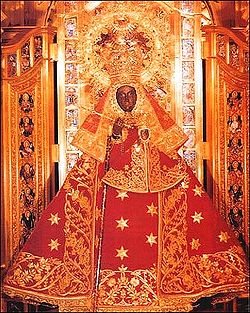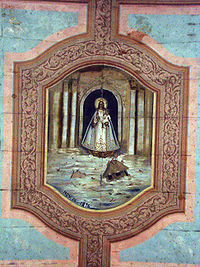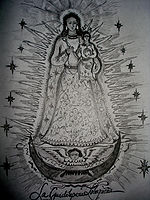- Our Lady of Guadalupe, Extremadura
-
This article is about the Spanish statue. For the Mexican icon, see Our Lady of Guadalupe.
The shrine to Our Lady of Guadalupe was the most important Marian shrine in the medieval kingdom of Castile. It is revered in the monastery of Santa María de Guadalupe, in today's Cáceres province of the Extremadura autonomous community of Spain.
Our Lady of Guadalupe is one of three Black Madonnas in Spain. The statue was canonically crowned in 1928 with a crown designed and crafted by Father Felix Granda.
Contents
Shrine
The shrine housed a statue reputed to have been carved by Luke the Evangelist and given to Saint Leander, archbishop of Seville, by Pope Gregory I. When Seville was taken by the Moors, a group of priests fled northward and buried the statue in the hills near the Guadalupe River in Extremadura. At the beginning of the 14th century, a shepherd claimed that the Virgin Mary had appeared to him and ordered him to ask priests to dig at the site of the apparition. Excavating priests rediscovered the hidden statue and built a small shrine around it which evolved into the great Guadalupe monastery.
Pilgrimage
Pilgrims began arriving in 1326, and in 1340, King Alfonso XI took a personal interest in the shrine's development, attributing his victory over the Moors at the Battle of Rio Salado to the Virgin's intercession. Our Lady of Guadalupe, along with Santiago de Compostela and Nuestra Señora del Pilar became rallying points for the Christian Spaniards in their reconquista of Iberia.
Cult
In 1386, the shrine was commended to the Hieronymites, who turned the popular devotion to the figure into a genuine cult. Copies of the statue were venerated in satellite chapels.
Mexico
The name of the Mexican Lady of Guadalupe derives from the Extremadura, homeland of many conquistadors, including Hernán Cortés.
The Philippines
The Augustinians helped spread the devotion to Our Lady of Guadalupe (Extremadura) in the Philippines through mission works. The assignment of priests from Caceres, Spain contributed to the development of yet another devotion in this new Spanish territory. In 1843, an image of Our Lady of Guadalupe arrived in the Visayan province of Bohol. The image was brought from Spain by Augustinian Recollects who were charged to take care of ecclessiastical functions in Bohol after the expulsion of the Jesuits in the 18th century.
Miracles of the Virgen de Guadalupe of Loboc
Loboc documented so many miracles which they attribute to the loving intercession of the Virgen de Guadalupe. Foremost of which happened on November 26, 1876. As immortalized in a painting on the ceiling of Loboc Church by renowned Cebuano painter Ray Francia, a flood plunged Loboc wreaking havoc to the whole town. The water went up submerging the altar of Loboc Church but leaving the image unscathed as the waters calmly stopped at the base of the image of the Virgen de Guadalupe. The Lobocanons added that despite the extent of the flood, they were left unharmed and no casualties recorded.
Many devotees from other places in the Philippines also attend the Maytime festival to honor the Virgen de Guadalupe and to ask for her miraculous intercessions. Other childless mothers who went to Loboc in May to dance the bolibongkingking before her image return to her shrine offering their child, the fruit of their supplication to God through the prayers of the Virgen de Guadalupe. Some, whose prayers have been answered return to Loboc in thanksgiving and present new vestments and metal ornaments to the Virgen de Guadalupe, the devotional patroness of Loboc.
The Bolibongkingking Festival
The people of Loboc honor the Virgen de Guadalupe every 24th of May. During this festival Lobocanons celebrate the feast with music and merrymaking. The celebrations start nine-days prior to the May 24 feast with the GOZOS or a ballad of praises to the Blessed Virgin Mary sung in vernacular or Latin before the start of novena masses.
On the eve of the feast day of the Virgen de Guadalupe, a fluvial parade takes place in the idyllic Loboc River. During the activity, the image is brought on a floating restaurant while Marian songs, marches and processional hymns are played. Dignitaries from both church and state participate in the procession to relive the moment when the cholera epidemic ceased when Lobocanons brought the image of the Virgen de Guadalupe on a fluvial procession in the 1840s.
Derived from the sounds of indigenous musical instruments used, the drums (bolibong) and gongs (kingking), the Bolibongkingking Festival is celebrated during the feast proper of the Virgen de Guadalupe. Believed to be both a healing ritual and dance of thanksgiving, the faithful devotees of the Blessed Mother dance to the attractive rhythm of drums and gongs before her image swaying their hands and lifting their petitions or thanksgiving to God through the intercession of the Virgen de Guadalupe.
Categories:- History of Spain
- Marian apparitions
- Marian shrines
- Titles of Mary
- Our Lady of Guadalupe
Wikimedia Foundation. 2010.




